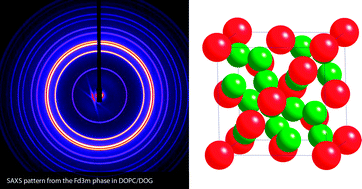Over a range of hydration, unsaturated diacylglycerol/phosphatidylcholine mixtures adopt an inverse micellar cubic phase, of crystallographic space group Fd3m. In this study hydrated DOPC:DOG mixtures with a molar ratio close to 1 ∶ 2 were examined as a function of hydrostatic pressure, using synchrotron X-ray diffraction. The small-angle diffraction pattern at atmospheric pressure was used to calculate 2-D sections through the electron density map. Pressure initially has very little effect on the structure of the Fd3m cubic phase, in contrast to its effect on hydrated inverse bicontinuous cubic phases. At close to 2 kbar, a sharp transition occurs from the Fd3m phase to a pair of coexisting phases, an inverse hexagonal HII phase plus an (ordered) lamellar phase. Upon increasing the pressure to 3 kbar, a further sharp transition occurs from the HII phase to a (fluid) lamellar phase, in coexistence with the ordered lamellar phase. These transitions are fully reversible, but show hysteresis. Remarkably, the lattice parameter of the Fd3m phase is practically independent of pressure. These results show that these two lipids are miscible at low pressure, adopting a single lyotropic phase (Fd3m); they then become immiscible above a critical pressure, phase separating into DOPC-rich and DOG-rich phases.

You have access to this article
 Please wait while we load your content...
Something went wrong. Try again?
Please wait while we load your content...
Something went wrong. Try again?


 Please wait while we load your content...
Please wait while we load your content...